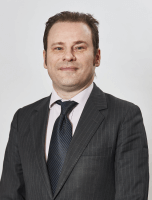 Science fiction fans all over the planet hyperventilated with glee as The Force Awakens, the new instalment in the Star Wars saga, hit cinema screens in December 2015. The film introduced some new characters (thankfully none as bad as Jar Jar Binks in 1999’s The Phantom Menace) – one of which was a new robot droid, the BB-8. The BB-8 droid has a unique movement which is the subject of a granted US patent (discussed below). But it is not the only piece of Star Wars technology which has applications in real life.
Science fiction fans all over the planet hyperventilated with glee as The Force Awakens, the new instalment in the Star Wars saga, hit cinema screens in December 2015. The film introduced some new characters (thankfully none as bad as Jar Jar Binks in 1999’s The Phantom Menace) – one of which was a new robot droid, the BB-8. The BB-8 droid has a unique movement which is the subject of a granted US patent (discussed below). But it is not the only piece of Star Wars technology which has applications in real life.
The BB-8
The movement of the BB-8 droid in The Force Awakens is the subject of US Patent 8269447 entitled ‘Magnetic spherical balancing robot drive’ which was first filed in 2010. It is owned by Disney Enterprises, Inc. (Figure 1). The BB-8 operates by way of a holonomic drive system. It includes a spherical body 111 and holonomic drive 120 having wheels 110 together with a magnet assembly on the drive 120 to urge wheels 110 against the surface of the sphere. The movement of the sphere is thus controlled in response to the rotation of the wheels 110.
Princess Leia and Tupac Holograms
A very famous scene in Star Wars: A New Hope (1977) features another droid, R2-D2, who plays back a holographic recording of Princess Leia pleading ‘Help me, Obi-Wan Kenobi. You’re my only hope’. Cut to 35 years later and we see the first ‘holographic’ music performance by the late rapper, Tupac Shakur. Some would argue that the Tupac hologram was not a true hologram, but rather a two-dimensional projection based on an old theatre illusion known as ‘Pepper’s Ghost’. The technology, developed by Musion Das Hologram Ltd was patented in the United States in 2013 as US 8,462,192.
The Death Star
The Death Star, which features in numerous Star Wars films, is a weapon capable of destroying a planet via a focused ‘superlaser’. You may be horrified to know that Lockheed Martin have developed and patented a direct energy weapon which combines multiple laser beams into one high-power output beam. Helpfully, Lockheed Martin have extensively described how the invention works in their patent specification and it is easily downloadable from the US Patent Office – obviating the need for a band of rebels from the Rebel Alliance to steal the plans for the Death Star. In addition, unauthorised use of said Death Star in the United States by the Galactic Empire may well be a patent infringement.
Force Field
Not to be outdone by Lockheed Martin, Boeing have developed a force field (or as it is known in Star Wars, a deflector shield) entitled a ‘Method and system for shockwave attenuation via electromagnetic arc’. Sadly, like Star Wars deflector shields, this technology only applies to assets like vehicles and does not protect individuals from shockwaves – so Greedo’s fate was sealed when he was shot with Han Solo’s blaster (of course Han shot first).
These are not the Droids® you are looking for
In addition to the mechanism of the BB-8 droid being patented, the word DROID was itself coined by the creator of Star Wars, George Lucas, and is a registered trademark in a number of countries. A little over three years ago, Lucasfilm Entertainment successfully opposed registration of a similar Australian trademark (BIODROID) relying on Section 60 (well-known/famous trademarks).
The Hearing Officer in that case accepted Lucasfilm’s evidence that they created the mark ‘droid’ and developed numerous ‘droid characters’ since 1977, and that they had an extensive reputation in Australia such that DROID was well known. Lucasfilm’s evidence in the case, helpfully clarified the purpose and type of each ‘droid’:
‘The nature or purpose of each type of DROID is often conveyed by the script of additional word elements such as ‘astromech droids’ (such as the R2-D2 character), ‘protocol droids’ (such as the
C-3PO character), and ‘battle droids’, to name just a few.’
Thus, the innovative patented technology used throughout the Star Wars series demonstrates that the beloved sci-fi saga does surprisingly hold some degree of science fact.

